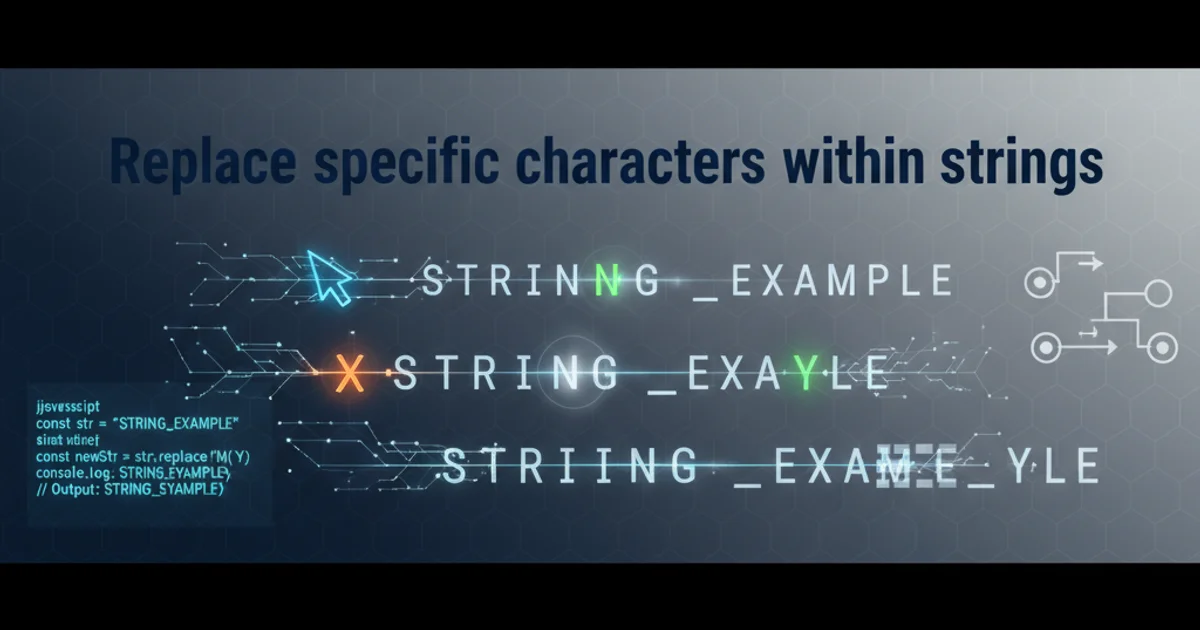Replace specific characters within strings
Categories:
Mastering String Character Replacement in R

Learn how to effectively replace specific characters or patterns within strings in R using base functions and regular expressions.
String manipulation is a fundamental task in data cleaning and preparation. In R, replacing specific characters or patterns within strings is a common requirement. This article will guide you through various methods to achieve this, from simple character substitutions to complex pattern replacements using regular expressions. We'll cover base R functions like sub(), gsub(), chartr(), and str_replace() from the stringr package, providing practical examples and best practices.
Basic Character Replacement with sub() and gsub()
The sub() and gsub() functions are the workhorses for string replacement in R. They allow you to find a pattern and replace it with a new string. The key difference is that sub() replaces only the first occurrence of the pattern, while gsub() replaces all occurrences.
# Example 1: Replacing the first occurrence
my_string <- "hello world hello"
sub("hello", "hi", my_string)
# Example 2: Replacing all occurrences
my_string <- "hello world hello"
gsub("hello", "hi", my_string)
# Replacing a specific character
text_data <- "data-science-is-fun"
gsub("-", " ", text_data)
Using sub() and gsub() for basic string replacement.
sub() and gsub() treat the pattern argument as a regular expression by default. If you need to replace special characters (like ., *, +, ?, |, (, ), [, ], \, ^, $) literally, you must escape them with a double backslash (e.g., \\.).Translating Characters with chartr()
For one-to-one character translation, where you want to replace a set of characters with another set of characters of the same length, chartr() is highly efficient. It takes three arguments: old characters, new characters, and the x string. Each character in old is replaced by the corresponding character in new.
# Example: Replacing vowels with asterisks
my_text <- "programming in R is great"
chartr("aeiou", "*****", my_text)
# Example: Converting case
word <- "HeLlO"
chartr("aeiouAEIOU", "AEIOUaeiou", word)
Demonstrating chartr() for character translation.
flowchart TD
A[Input String] --> B{Identify Replacement Goal}
B --"Replace first/all occurrences of pattern"--> C[Use sub()/gsub()]
B --"Translate specific characters (1:1)"--> D[Use chartr()]
C --> E[Output String]
D --> EDecision flow for choosing string replacement functions.
Advanced Replacement with Regular Expressions
Regular expressions (regex) provide powerful pattern matching capabilities. When combined with gsub(), you can perform highly flexible and complex character replacements. This is particularly useful for cleaning messy data, extracting specific information, or standardizing formats.
# Example: Removing all non-alphanumeric characters
raw_string <- "Hello, World! 123 (test)."
gsub("[^[:alnum:] ]", "", raw_string)
# Example: Replacing multiple spaces with a single space
spaced_string <- "This has too many spaces."
gsub(" +", " ", spaced_string)
# Example: Replacing leading/trailing whitespace
trim_string <- " leading and trailing "
gsub("^\s+|\s+$", "", trim_string)
Using regular expressions with gsub() for advanced replacements.
. (any character), * (zero or more), + (one or more), ? (zero or one), [] (character set), () (grouping), \d (digit), \s (whitespace), ^ (start of string), $ (end of string).Using stringr::str_replace() and str_replace_all()
The stringr package, part of the tidyverse, offers a more consistent and user-friendly interface for string manipulation, including replacement. str_replace() is analogous to sub(), replacing the first match, while str_replace_all() is like gsub(), replacing all matches. These functions are often preferred for their readability and integration with the tidyverse workflow.
# Install and load stringr if you haven't already
# install.packages("stringr")
library(stringr)
my_sentence <- "The quick brown fox jumps over the lazy dog. The fox is quick."
# Replace first occurrence
str_replace(my_sentence, "fox", "cat")
# Replace all occurrences
str_replace_all(my_sentence, "fox", "cat")
# Using a named vector for multiple replacements
multiple_replacements <- c("quick" = "fast", "lazy" = "sleepy")
str_replace_all(my_sentence, multiple_replacements)
String replacement using stringr::str_replace() and str_replace_all().
str_replace_all() with a named vector for multiple replacements, be mindful of the order if patterns can overlap. The replacements are applied sequentially based on the order of elements in the named vector.1. Identify the Target
Determine exactly what characters or patterns you need to replace within your strings. Consider if it's a fixed character, a set of characters, or a complex pattern.
2. Choose the Right Tool
For simple, one-to-one character translation, use chartr(). For single or all occurrences of a pattern, use sub() or gsub(). For tidyverse integration and enhanced readability, opt for stringr::str_replace() or str_replace_all().
3. Construct Your Pattern
If using sub(), gsub(), or stringr functions, decide if you need a literal string or a regular expression. Escape special characters if necessary for literal matching.
4. Test and Refine
Always test your replacement logic on a subset of your data or example strings to ensure it behaves as expected before applying it broadly.